Blog Archives
Increasing Number of Diabetic Amputations
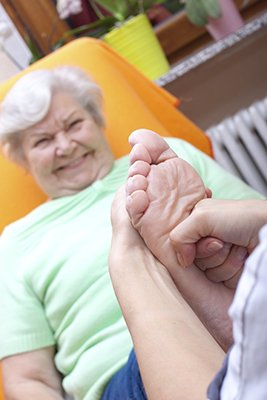 Information from the International Diabetes Federation revealed that each year a great number of diabetic patients undergo amputation of the leg. Proper foot health education may prevent the need of amputations among diabetics. It is also important to perform daily feet checks, keep your feet clean and moisturized, wear proper footwear, and visit your podiatrist regularly.
Information from the International Diabetes Federation revealed that each year a great number of diabetic patients undergo amputation of the leg. Proper foot health education may prevent the need of amputations among diabetics. It is also important to perform daily feet checks, keep your feet clean and moisturized, wear proper footwear, and visit your podiatrist regularly.
Diabetic foot care is important in preventing foot ailments such as ulcers. If you are suffering from diabetes or have any other concerns about your feet, contact Dr. Sharon Pletcher of Pennsylvania. Our doctor can provide the care you need to keep your pain free and on your feet.
Diabetic Foot Care
Diabetes affects millions of people every year. Diabetes can damage blood vessels in many parts of the body, including the feet. Because of this, taking care of your feet is essential if you have diabetes, and having a podiatrist help monitor your foot health is highly recommended.
The Importance of Caring for Your Feet
- Routinely inspect your feet for bruises or sores.
- Wear socks that fit your feet comfortably.
- Wear comfortable shoes that provide adequate support.
Patients with diabetes should have their doctor monitor their blood levels because blood sugar levels play such a huge role in diabetic care. Monitoring these levels on a regular basis is highly advised.
It is always best to inform your healthcare professional of any concerns you may have regarding your feet, especially for diabetic patients. Early treatment and routine foot examinations are keys to maintaining proper health, especially because severe complications can arise if proper treatment is not applied.
If you have any questions please feel free to contact one of our offices located in State College, PA. We offer the newest diagnostic and treatment technologies for all your foot and ankle needs.
“Fighting Through the Pain” May Result in Injury
 In the past decade, more and more people have been engaging in fitness activities. Some of these activities include running marathons, trail running, and cycling. However, a lot of these people are not aware of the stress they put their bodies in order to participate in these activities. According to Dr. Laungani, “the golden rule is to learn to listen to [your] body.” Your body will tell you when your fitness routine is too strenuous for you to handle. Fighting through the pain that comes along with too much running can result in injury.
In the past decade, more and more people have been engaging in fitness activities. Some of these activities include running marathons, trail running, and cycling. However, a lot of these people are not aware of the stress they put their bodies in order to participate in these activities. According to Dr. Laungani, “the golden rule is to learn to listen to [your] body.” Your body will tell you when your fitness routine is too strenuous for you to handle. Fighting through the pain that comes along with too much running can result in injury.
Runners can still be prone to running injuries even with proper precautions. If you are suffering from a running injury, contact Dr. Sharon Pletcher of Pennsylvania. Our doctor can provide the care you need to keep your pain free and on your feet.
How to Prevent Running Injuries
Many common running injuries are caused by overuse and overtraining. When the back of the kneecap starts wearing out and starts causing pain in your knee, this is commonly referred to as runner’s knee. Runner’s knee is a decrease in strength in your quadriceps and can occur if you’re not wearing properly fitted or supporting shoes. To prevent runner’s knee, focusing on hip strengthening is a good idea, as well as strengthening your quads to keep the kneecaps aligned.
What Are Some Causes of Running Injuries?
- One cause of a common running injury is called iliotibial band syndrome.
- Plantar fasciitis is also another common injury.
- Stress fractures can occur from overtraining, lack of calcium, or even your running style.
Best Ways to Prevent Running Injuries
- Wear footwear that fits properly and suits your running needs.
- Running shoes are the only protective gear that runners have to safeguard them from injury.
- Make a training schedule. Adding strengthening exercises as well as regular stretching can help keep you strong and limber and can lessen the possibility of injuries.
- Stretching keeps muscles limber, this will help you gain better flexibility.
If you have any questions please feel free to contact our office located in State College, PA. We offer the newest diagnostic tools and technology to treat your foot and ankle needs.
Sever’s Disease Common Among Younger Athletes
 One of the most common injuries among young soccer players is heel pain. This is often the result of a condition called apophystis, which is also known as Sever’s Disease. This condition occurs when there is inflammation of the heel plate of the heel bone. In younger players, this area has not fully matured. The pain associated with Sever’s Disease tends to be more common in running and jumping sports.
One of the most common injuries among young soccer players is heel pain. This is often the result of a condition called apophystis, which is also known as Sever’s Disease. This condition occurs when there is inflammation of the heel plate of the heel bone. In younger players, this area has not fully matured. The pain associated with Sever’s Disease tends to be more common in running and jumping sports.
When dealing with systemic disease of the feet, is extremely important to check the affected areas routinely so that any additional problems are caught quickly. If you have any concerns about your feet and contact Dr. Sharon Pletcher of Pennsylvania. Our doctor can provide the care you need to keep your pain free and on your feet.
Systemic Diseases of the Feet
Systemic diseases affect the whole body, and symptoms usually are displayed in the feet. This condition can make a patient’s ability to walk unbearable. Systemic diseases include gout, diabetes mellitus, neurological disorders, and arthritis.
Gout – is caused by an excess of uric acid in the body. Common symptoms include pain, inflammation, and redness at the metatarsal/phalangeal joint of the base big toe. Gout can be treated by NSAIDs to relieve pain and inflammation, and other drugs that lower the acid levels in the body.
Diabetes mellitus – is an increase in the level of blood sugar that the body cannot counteract with its own insulin. Failure to produce enough insulin is a factor in Diabetes.
Diabetes of the Feet
Diabetic Neuropathy – may lead to damaged nerves and affect the feet through numbness and loss of sensation.
Peripheral Vascular Disease – can restrict the blood flow to the feet, and often times lead to amputation of the feet.
If you have any questions, please feel free to contact our office located in State College, PA. We offer the newest diagnostic and treatment technologies for all your foot care needs.
Sammy Watkins Recovers from Stress Fracture
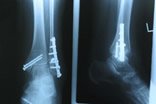 Wide Receiver Sammy Watkins had foot surgery in April to repair a stress fracture in his left foot, and had gradually increased his activity so that he could make a return for the season opener. Watkins had started in the season opener, but had to be evaluated the next day for what appeared to be soreness in his foot. Watkins, however, was confident that the pain was not a cause for alarm. However, according to the article, it is crucial for an athlete to properly recover and take it slow after healing from a stress fracture injury, as the bone is still remodeling itself and the risk of injury is still high.
Wide Receiver Sammy Watkins had foot surgery in April to repair a stress fracture in his left foot, and had gradually increased his activity so that he could make a return for the season opener. Watkins had started in the season opener, but had to be evaluated the next day for what appeared to be soreness in his foot. Watkins, however, was confident that the pain was not a cause for alarm. However, according to the article, it is crucial for an athlete to properly recover and take it slow after healing from a stress fracture injury, as the bone is still remodeling itself and the risk of injury is still high.
Activities where too much pressure is put on the feet can cause stress fractures. To learn more, contact Dr. Sharon Pletcher of Pennsylvania. Our doctor can provide the care you need to keep your pain free and on your feet.
Dealing with Stress Fractures of the Foot and Ankle
The Stress Fractures occur on the foot and ankle when muscles in these areas weaken from too much or too little use. Then the feet and ankles lose support when walking or running from the impact of the ground. Since there is no protection the bones receive the full impact of each step. The stress on the feet causes cracks to form in the bones, thus called stress fractures.
What are Stress Fractures?
Stress fractures occur frequently in individuals whose daily activities cause great impact on the feet and ankles. Stress factors are most common among:
-runners
-people affected with Osteoporosis
-play tennis or basketball
-gymnastics
-high impact workouts
Symptoms
Pain from the fractures occur in the area of the fractures, and can be constant or intermittent. It will often cause sharp or dull pain with swelling and tenderness. Engaging in any kind of activity which involves in high impact will aggravate pain.
If you have any questions, please feel free to contact our office located in State College, PA. We offer the newest diagnostic and treatment technologies for all your foot care needs.
How to Find Proper Fitting Shoes for Your Children
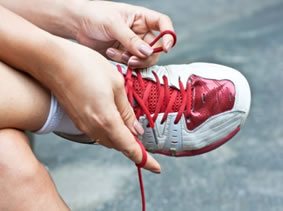 Now that it is time for kids to go back-to-school, they may need a new pair of shoes before they start the new school year. It is important that you assist your child in picking out a new pair of shoes for school, because wearing proper-fitting shoes is key to the health of your feet. You should always make sure that your child is going for a shoe that is healthy for his or her feet, rather than one that is stylish.
Now that it is time for kids to go back-to-school, they may need a new pair of shoes before they start the new school year. It is important that you assist your child in picking out a new pair of shoes for school, because wearing proper-fitting shoes is key to the health of your feet. You should always make sure that your child is going for a shoe that is healthy for his or her feet, rather than one that is stylish.
Finding a properly-fitting shoe is important in reducing injuries and preventing foot problems. For more information about treatment, contact Dr. Sharon Pletcher of Pennsylvania. Our doctor can provide the care you need to keep your pain free and on your feet.
Proper Shoe Fitting
A common concern when it comes to foot health, having properly fitted shoes can help prevent injuries to the foot. Out feet affect our posture and gait, which in turn affects the biomechanics and overall bodily structure. With 33 joints, 26 bones, and over 100 ligaments, the potential for serious injury is much greater than one realizes. Although the feet cease growth in adulthood, they still change shape as they mature. Here are some factors to consider when it comes to investing in proper fitting shoes:
- Be sure the shoes fit correctly right away
- Ensure the ball of your foot fits comfortably in the widest portion of the shoes
- Even though they may look fashionable, improper fitting shoes can either create adverse conditions or exacerbate existing ones you may already have
- Walk along a carpeted surface to ensure the shoes comfortably fit during normal activity
Keeping in mind how shoes fit the biomechanics of your body, properly-fitting shoes is vitally important. Fortunately, it is not difficult to acquire footwear that fits correctly. Be sure to wear shoes that support the overall structure of your body. Do your feet a favor and invest in several pairs of well-fitted shoes today.
If you have any questions, please feel free to contact our office located in State College, PA. We offer the newest diagnostic and treatment technologies for all your foot care needs.
Flat Feet Risk Factors
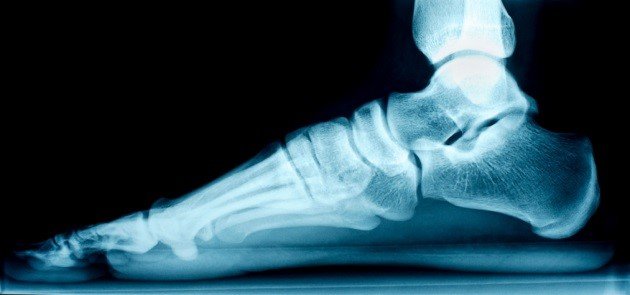 Flat foot is a condition commonly caused by a dysfunction of the posterior tibial tendon, a tendon of the ankle. Other factors that can increase the risk of flat feet include, “high blood pressure, obesity, diabetes, previous surgery or trauma, rheumatoid arthritis, and exposure to steroids.” Older individuals as well as previous injury to the area can lead to the development of flatfoot. Seek medical attention to ensure proper prevention of the progression of the condition.
Flat foot is a condition commonly caused by a dysfunction of the posterior tibial tendon, a tendon of the ankle. Other factors that can increase the risk of flat feet include, “high blood pressure, obesity, diabetes, previous surgery or trauma, rheumatoid arthritis, and exposure to steroids.” Older individuals as well as previous injury to the area can lead to the development of flatfoot. Seek medical attention to ensure proper prevention of the progression of the condition.
Flatfoot is a condition many people suffer from. If you have flat feet, contact Dr. Sharon Pletcher of Pennsylvania. Our doctor will assist you with all of your podiatric concerns.
What are Flat Feet?
Flat feet are a condition in which the arch of the foot is depressed and the sole of the foot is almost completely in contact with the ground. Standing about 20-30% of the population generally has flat feet because their arch never formed during growth.
Conditions & Problems:
Having flat feet makes it difficult to run or walk because of the stress placed on the ankles.
Alignment – The general alignment of your legs can be disrupted, because the ankles move inward which can cause major discomfort.
Knees – if you have complications with your knees, flat feet can be a contributor to arthritis in that area.
Symptoms:
Pain around the heel or arch area
Trouble standing on the tip toe.
Swelling around the inside of the ankle.
Flat look to one or both feet.
Having your shoes feel uneven when worn
Treatment:
If you are experiencing pain and stress on the foot you may weaken the posterior tibial tendon, which runs around the inside of the ankle.
If you have any questions please feel free to contact our office located in State College, PA. We offer the newest diagnostic and treatment technologies for all your foot and ankle needs.
Jacob Maxwell Undergoes Foot Surgery
 Wisconsin’s starting right tackle, Jacob Maxwell, recently admitted that he suffered an injury in his left foot. He revealed that he underwent surgery to repair a stress fracture in his foot. Maxwell wasn’t cleared for workouts until three weeks prior to camp. He states that this was a setback, however he is continuing to get stronger and better again.
Wisconsin’s starting right tackle, Jacob Maxwell, recently admitted that he suffered an injury in his left foot. He revealed that he underwent surgery to repair a stress fracture in his foot. Maxwell wasn’t cleared for workouts until three weeks prior to camp. He states that this was a setback, however he is continuing to get stronger and better again.
Foot surgery is sometimes necessary to fix a foot ailment. To learn more, contact Dr. Sharon Pletcher of Pennsylvania. Our doctor can provide the care you need to keep you pain-free and on your feet.
When Is Surgery Necessary?
Foot and ankle surgery is generally reserved for cases in which less invasive, conservative procedures have failed to help with the problem. Some of the cases in which surgery may be necessary are:
- Removing foot deformities like bone spurs and bunions
- Severe arthritis that has caused bone issues
- Cosmetic reconstruction
What Types of Surgery Are There?
The type of surgery you receive will depend on the nature of the problem you have. Some of the possible surgeries include:
- Bunionectomy for painful bunions
- Surgical fusion for realignment of bones
- Neuropathy decompression surgery to treat nerve damage
Benefits of Surgery
Although surgery is usually a last resort, it can provide more complete pain relief compared to non-surgical methods and may allow you to finally resume full activity.
Surgical techniques have also become increasingly sophisticated. Techniques like endoscopic surgery allow for smaller incisions and faster recovery times.
If you have any questions please feel free to contact our office located in State College, PA. We offer the newest diagnostic and treatment technologies for all your foot and ankle needs.
High Heels May Negatively Impact Foot Health
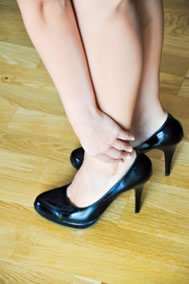 A study published by the Journal of Applied Physiology has determined that long-term high heel use can have detrimental effects on the legs’ muscles, such as muscle strain and muscle fatigue. According to the study’s abstract, long-term high heel use has been found to “shorten medial gastrocnemius muscle fascicles and increase Achilles tendon stiffness.” The study’s results are consistent with reports that high heel wearers often experience discomfort, pain, and tiredness. It also suggests that “long-term high heel use may compromise muscle efficiency in walking”.
A study published by the Journal of Applied Physiology has determined that long-term high heel use can have detrimental effects on the legs’ muscles, such as muscle strain and muscle fatigue. According to the study’s abstract, long-term high heel use has been found to “shorten medial gastrocnemius muscle fascicles and increase Achilles tendon stiffness.” The study’s results are consistent with reports that high heel wearers often experience discomfort, pain, and tiredness. It also suggests that “long-term high heel use may compromise muscle efficiency in walking”.
High heels have a history for causing foot and ankle problems. If you have any concerns about your feet or ankles, contact Dr. Sharon Pletcher of Pennsylvania. Our doctor can provide the care you need to keep your pain free and on your feet.
Effects of High Heels on the Feet
High heels are popular shoes among women because their style and societal appeal. Despite this, they can still cause many health problems if worn too frequently.
What parts my body will be affected by high heels?
- Ankle Joints
- Achilles Tendon – may shorten and stiffen with prolonged wear
- Balls of the Feet
- Knees – heels cause the knees to bend constantly, creating stress on them
- Back – they decrease the spine’s ability to absorb shock, which may lead to back pain. Also, the vertebrae of the lower back may compress.
What kinds of foot problems can develop from wearing high heels?
- Corns
- Calluses
- Hammertoe
- Bunions
- Morton’s Neuroma
- Plantar Fasciitis
How can I still wear high heels and maintain foot health?
If you want to wear high heeled shoes, make sure that you are not wearing them every day, as this will help prevent long term physical problems. Try wearing thicker heels as opposed to stilettos to distribute weight more evenly across the feet. Always make sure you are wearing the proper shoes for the right occasion, such as sneakers for exercising. If you walk to work, try carrying your heels with you and changing into them once you arrive at work. Adding inserts to your heels can help cushion your feet and absorb shock. Full foot inserts or metatarsal pads are available.
If you have any questions please feel free to contact our offices located in State College, PA. We offer the newest diagnostic tools and technology to treat your foot and ankle needs.
Study Could Predict Susceptibility of Rheumatoid Arthritis
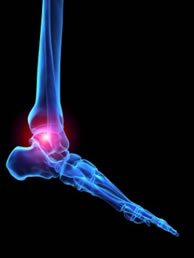 Rheumatoid arthritis is an autoimmune disorder, or a condition in which the body attacks itself. Bacteria in the gut has been found to predict susceptibility of rheumatoid arthritis. Experts were able to study microbes that were normally low in healthy individuals, but high in people with rheumatoid arthritis. This study could be used to predict if someone is likely to have rheumatoid arthritis in the future.
Rheumatoid arthritis is an autoimmune disorder, or a condition in which the body attacks itself. Bacteria in the gut has been found to predict susceptibility of rheumatoid arthritis. Experts were able to study microbes that were normally low in healthy individuals, but high in people with rheumatoid arthritis. This study could be used to predict if someone is likely to have rheumatoid arthritis in the future.
Because RA affects more than just your joints, including the joints in your feet and ankles, it is important to seek early diagnosis from your podiatrist if you feel like the pain in your feet might be caused by RA. For more information, contact Dr. Sharon Pletcher of Pennsylvania. Our doctor can provide the care you need to keep your pain free and on your feet.
What Is Rheumatoid Arthritis?
Rheumatoid Arthritis (RA) is an autoimmune disorder in which the body’s own immune system attacks the membranes surrounding the joints. Inflammation of the lining and eventually the destruction of the joint’s cartilage and bone occur, causing severe pain and immobility.
Rheumatoid Arthritis of the Feet
Although RA usually attacks multiple bones and joints throughout the entire body, almost 90 percent of cases result in pain in the foot or ankle area.
Symptoms
- Swelling & pain in the feet
- Stiffness in the feet
- Pain on the ball or sole of feet
- Joint shift and deformation
Diagnosis
Quick diagnosis of RA in the feet is important so that the podiatrist can treat the area effectively. Your doctor will ask you about your medical history, occupation, and lifestyle to determine the origin of the condition. Rheumatoid Factor tests help to determine if someone is affected by the disease.
If you have any questions, please feel free to contact our offices located in State College, PA. We offer the newest diagnostic and treatment technologies for all your foot care needs.
DIY Pedicures can help maintain Healthy Feet
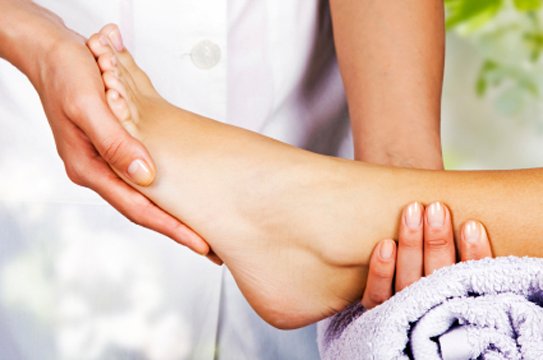 Pedicures are very important when it comes to maintaining healthy feet. Prior to giving yourself a pedicure, you should soak your feet in hot water with bath salts or oils. Soaking your feet will help soften calluses and remove any unwanted particles from your skin. The next step in your DIY pedicure is to trim your toenails. Trimming your toenails will help prevent dirt from being trapped underneath them. You should be careful to cut straight across when trimming your nails, in order to prevent ingrown toenails. Be sure to file your nails in the same direction in order to avoid damaging your nails.
Pedicures are very important when it comes to maintaining healthy feet. Prior to giving yourself a pedicure, you should soak your feet in hot water with bath salts or oils. Soaking your feet will help soften calluses and remove any unwanted particles from your skin. The next step in your DIY pedicure is to trim your toenails. Trimming your toenails will help prevent dirt from being trapped underneath them. You should be careful to cut straight across when trimming your nails, in order to prevent ingrown toenails. Be sure to file your nails in the same direction in order to avoid damaging your nails.
Every day foot care is very important to prevent infection and other foot ailments. If you need your feet checked, contact Dr. Sharon Pletcher of Pennsylvania. Our doctor can provide the care you need to keep your pain free and on your feet.
Every Day Foot Care
Often, people take care of their bodies, face and hair more so than they do for their feet. But the feet are a very important aspect of our bodies, and one that we should pay more attention to. After all, without our feet, we would not be able to perform most daily tasks. It is best to check your feet regularly to make sure there are no new bruises or cuts that you may not have noticed before, for example.
For dry feet, moisturizer can easily be a remedy and can be applied as often as necessary to the affected areas. Wearing shoes that fit well can also help you maintain good foot health, as well as making it easier to walk and do daily activities without the stress or pain of ill-fitting shoes, high heels, or even flip flops.
Also, wearing clean socks with closed shoes is important to ensure that sweat and bacteria do not accumulate within the shoe. Clean socks help to prevent athlete’s foot, fungi problems, bad odors, and can absorb sweat.
If you have any questions, please feel free to contact our offices located in State College, PA. We offer the newest diagnostic and treatment technologies for all your foot care needs.
Read more about Everyday Foot Care
More...
Diabetics Need to Have Feet Screenings
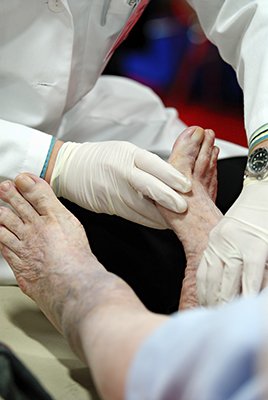 Diabetic foot is one of the top 20 causes of hospitalization in Australia. Studies conducted in the country found that one in every twenty-two patients in Australian hospitals have active diabetic foot disease. The disease is also responsible for over 4,400 amputations and 1,700 deaths each year. Nevertheless, early prevention is the best way to assure that diabetic foot does not progress into something much worse. It is recommended that every diabetic who goes to a hospital asks to have their foot screened for diabetic foot. Many people who have the disease often aren’t aware of it.
Diabetic foot is one of the top 20 causes of hospitalization in Australia. Studies conducted in the country found that one in every twenty-two patients in Australian hospitals have active diabetic foot disease. The disease is also responsible for over 4,400 amputations and 1,700 deaths each year. Nevertheless, early prevention is the best way to assure that diabetic foot does not progress into something much worse. It is recommended that every diabetic who goes to a hospital asks to have their foot screened for diabetic foot. Many people who have the disease often aren’t aware of it.
Diabetic foot care is important in preventing foot ailments such as ulcers. If you are suffering from diabetes or have any other concerns about your feet contact Dr. Sharon Pletcher of Pennsylvania. Our doctor can provide the care you need to keep your pain free and on your feet.
Diabetic Foot Care
Diabetes affects millions of people every year. Diabetes can damage blood vessels in many parts of the body, including the feet. Because of this, taking care of your feet is essential if you have diabetes, and having a podiatrist help monitor your foot health is highly recommended.
The Importance of Caring for Your Feet
- Routinely inspect your feet for bruises or sores.
- Wear socks that fit your feet comfortably.
- Wear comfortable shoes that provide adequate support.
Patients with diabetes should have their doctor monitor their blood levels because blood sugar levels play such a huge role in diabetic care. Monitoring these levels on a regular basis is highly advised.
It is always best to inform your healthcare professional of any concerns you may have regarding your feet, especially for diabetic patients. Early treatment and routine foot examinations are keys to maintaining proper health, especially because severe complications can arise if proper treatment is not applied.
If you have any questions, please feel free to contact our offices located in State College, PA. We offer the newest diagnostic and treatment technologies for all your foot care needs.
Read more about Diabetic Foot Care
Flip-Flops Might Be Bad for Your Feet
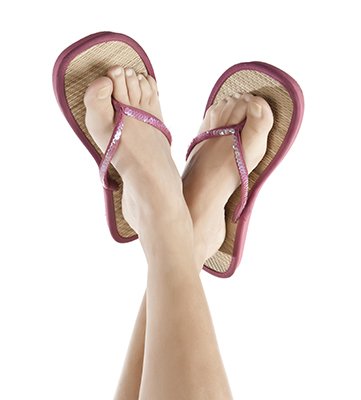 People often buy flip-flops with little knowledge on how they may affect your feet. Flip-flops do not offer much support for your feet, and they may cause plantar fasciitis. Wearing flip-flops also causes your toes to contract, which can cause hammertoe. When shopping for flip-flops you should look for durability, quality, and comfort. Heavy-duty flip flops that are made of soft leather instead of foam last extremely long and provide a lot of comfort. Thicker straps are also best when it comes to flip flops, because thin straps cut into the skin during aggressive activity.
People often buy flip-flops with little knowledge on how they may affect your feet. Flip-flops do not offer much support for your feet, and they may cause plantar fasciitis. Wearing flip-flops also causes your toes to contract, which can cause hammertoe. When shopping for flip-flops you should look for durability, quality, and comfort. Heavy-duty flip flops that are made of soft leather instead of foam last extremely long and provide a lot of comfort. Thicker straps are also best when it comes to flip flops, because thin straps cut into the skin during aggressive activity.
Flip-flops are not always the best choice of footwear. If you are seeking treatment, contact Dr. Sharon Pletcher of Pennsylvania. Our doctorwill assist you with all of your foot and ankle needs.
Flip-Flops and Feet
When the weather starts warming up, people enjoy wearing flip-flops. Flip-flops are comfortable, stylish, and easy to slip on and off, perfect for any summer beach goer. However, these shoes can cause harm to the feet.
How Can Flip-Flops Affect Me Long-Term?
- Ankle problems
- Hip problems
- Lower back problems
- Pain in the balls of the feet
- Problems with foot arches
- Changes in the way you walk
Are there injuries associated with flip-flops?
Yes. Since flip-flops are relatively weak and do not provide the same amount of support as sneakers, people who wear flip-flops are more susceptible to injuries. On top of that, the open nature of the shoe makes your feet more prone to other problems, such as cuts and even infections. Common injuries and ailments include:
- Sprained ankles
- Blisters
- Infections
- Cuts and Scrapes
I like wearing flip-flops, are there safe alternatives?
When buying flip-flops, try to find ones that have sturdy soles and are made of high quality materials that will support for your feet. These flip-flops will cost more, but will also last longer as a result.
If you have any questions, please feel free to contact our office located in State College, PA. We offer the newest diagnostic and treatment technologies for all your foot and ankle needs.
Read more about Flip-Flops and Your Feet
Man and Woman Suffer from Broken Ankles after Robbery
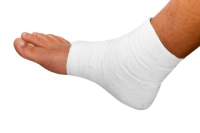 A group of kids robbed a 43-year-old woman and a 45-year-old man in Oldham. The man and woman suffered from fractures and broken ankles when the injury occurred on July 4th. Both victims are currently receiving treatment and the woman is expected to undergo surgery. The investigation to find the young men who committed the robbery is currently ongoing.
A group of kids robbed a 43-year-old woman and a 45-year-old man in Oldham. The man and woman suffered from fractures and broken ankles when the injury occurred on July 4th. Both victims are currently receiving treatment and the woman is expected to undergo surgery. The investigation to find the young men who committed the robbery is currently ongoing.
Broken ankles need immediate treatment. If you are seeking treatment,contact Dr. Sharon Pletcher of Pennsylvania. Our doctor can provide the care you need to keep you pain-free and on your feet.
Broken Ankles
A broken ankle is experienced when a person fractures their tibia or fibula in the lower leg and ankle area. Both of these bones are attached at the bottom of the leg and combine to form what we know to be our ankle.
When a physician is referring to a break of the ankle, he or she is usually referring to a break in the area where the tibia and fibula are joined to create our ankle joint. Ankles are more prone to fractures because the ankle is an area that suffers a lot of pressure and stress. There are some obvious signs when a person experiences a fractured ankle, and the following symptoms may be present.
Symptoms of a Fractured Ankle
- Excessive pain when the area is touched or when any pressure is placed on the ankle
- Swelling around the area
- Bruising of the area
- Area appears to be deformed
If you suspect an ankle fracture, it is recommended to seek treatment as soon as possible. The sooner you have your podiatrist diagnose the fracture, the quicker you’ll be on the way towards recovery.
If you have any questions please feel free to contact our office located in State College, PA.We offer the newest diagnostic and treatment technologies for all your foot and ankle needs.
Use Tape and Bracing to Prevent Ankle Sprains
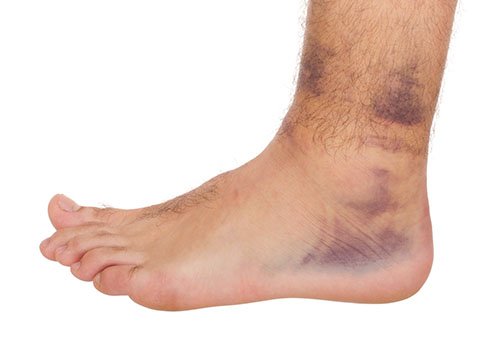 Unfortunately, ankle injuries are very common in the sport of netball. An ankle sprain occurs when the ligaments that connect bone to bone tear apart. Prophylactic tape and bracing can be used in order to prevent ankle sprains. There are different benefits that come along with taping your ankle compared to bracing, and vice-versa. A benefit of using tape is that it can be manipulated to fit your specific foot; however, the tape tends to loosen after about thirty minutes. A benefit of braces is that they provide extra support, but they cannot be tailored to fit a person’s foot.
Unfortunately, ankle injuries are very common in the sport of netball. An ankle sprain occurs when the ligaments that connect bone to bone tear apart. Prophylactic tape and bracing can be used in order to prevent ankle sprains. There are different benefits that come along with taping your ankle compared to bracing, and vice-versa. A benefit of using tape is that it can be manipulated to fit your specific foot; however, the tape tends to loosen after about thirty minutes. A benefit of braces is that they provide extra support, but they cannot be tailored to fit a person’s foot.
Ankle sprains are common, but need immediate attention. If you have any concerns about your feet or ankles, contact Dr. Sharon Pletcher of Pennsylvania. Our doctor will assist you with all of your foot and ankle needs.
How Does an Ankle Sprain Occur?
Ankle sprains take place when the ligaments in your ankle are torn or stretched beyond their limits. There are multiple ways that the ankle can become injured, including twisting or rolling over onto your ankle, putting undue stress on it, or causing trauma to the ankle itself.
What are the Symptoms?
- Mild to moderate bruising
- Limited mobility
- Swelling
- Discoloration of the skin (depending on severity)
Preventing a Sprain
- Wearing appropriate shoes for the occasion
- Stretching before exercises and sports
- Knowing your limits can aid in prevention
Treatment of a Sprain
Treatment of a sprain depends on the severity. Many times, people are told to rest and remain off their feet completely, while others are given an air cast. If the sprain is very severe, surgery may be required.
If you have suffered an ankle sprain previously, you may want to consider additional support such as a brace and regular exercises to strengthen the ankle.
If you have any questions, please feel free to contact our office located in State College, PA. We offer the newest diagnostic and treatment technologies for all your foot care needs.
Read more about ankle sprains.




